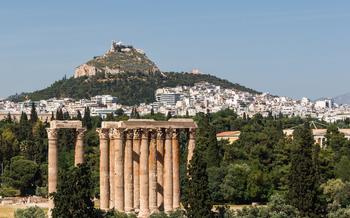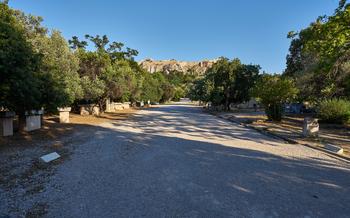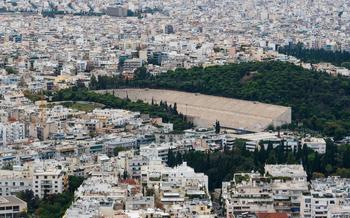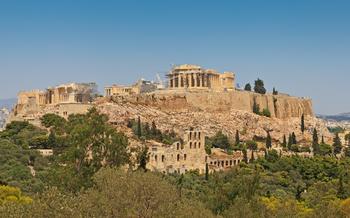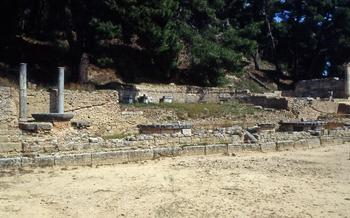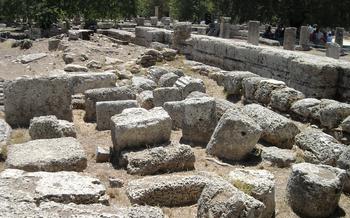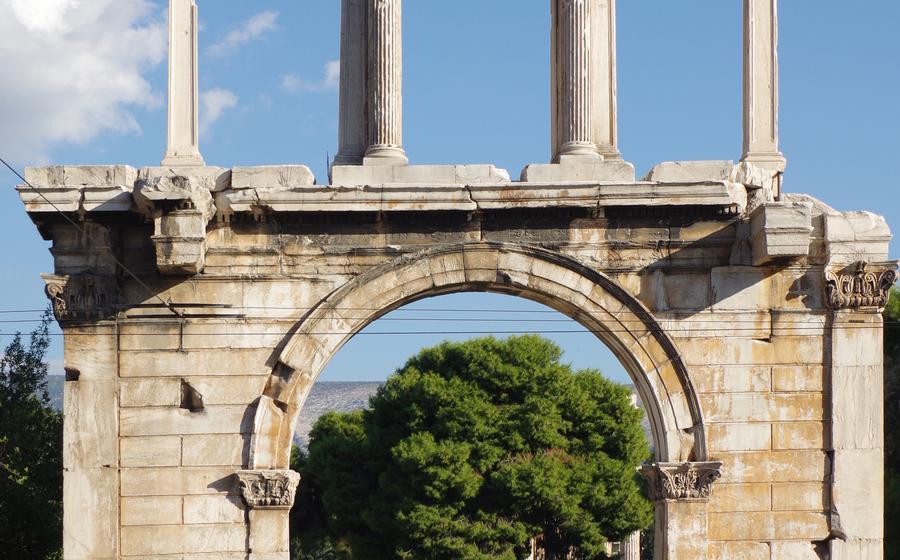
Hadrian's Arch
- Hadrian's Arch: A Majestic Symbol of Power and Grandeur
- Location: A Crossroads of History and Modernity
- The Arch's Architectural Prowess
- Historical Significance: A Window into the Roman Empire
- Visiting the Arch: A Step Back in Time
- Hadrian's Arch and the Changing Cityscape
- The Arch in Popular Culture
- Nearby Attractions: Enriching Your Visit
- Tips for Photography Enthusiasts
- Hadrian's Arch and the Olympic Games
- The Arch's Role in Cultural Events
- Safety and Accessibility
- Local Insights and Legends
- Sustainable Tourism Practices
Hadrian's Arch: A Majestic Symbol of Power and Grandeur
Hadrian's Arch stands as a testament to the grandeur and power of the Roman Empire. Built in 131 AD by Emperor Hadrian, the arch commemorates his visit to Athens and his benefactions to the city. This architectural marvel showcases intricate Corinthian columns, elaborate reliefs, and an impressive central arch, reflecting the skill and artistry of ancient Roman builders. As a prominent landmark and gathering place in Athens, the arch has witnessed centuries of history, serving as a symbol of the city's enduring legacy.
Location: A Crossroads of History and Modernity
Hadrian's Arch stands prominently in the heart of Athens, near Syntagma Square and the National Garden. Its central location makes it a natural gathering place and a symbol of the city's rich history and vibrant present.
The arch's proximity to Syntagma Square, the seat of the Greek Parliament, adds to its significance as a symbol of democracy and national pride. The square is a popular destination for both tourists and locals, who gather to witness the Changing of the Guards ceremony, a spectacle that takes place in front of the Parliament building every Sunday.
The National Garden, adjacent to the arch, offers a tranquil oasis amidst the bustling city. This lush green space is a popular spot for locals to relax, stroll, and escape the urban hustle. The garden's proximity to Hadrian's Arch creates a unique juxtaposition of ancient history and modern tranquility, making it a must-visit destination for anyone exploring Athens.
To reach Hadrian's Arch, visitors can conveniently take the metro to Syntagma Square station and walk a short distance. Alternatively, several bus lines stop nearby, providing easy access from different parts of the city. For those who prefer a leisurely stroll, the arch is within walking distance from many of Athens' other iconic landmarks, such as the Acropolis and the Plaka neighborhood.
The Arch's Architectural Prowess
Hadrian's Arch stands as a testament to the architectural prowess of the Roman Empire. Its Corinthian columns, intricately carved with acanthus leaves and volutes, exude an air of elegance and grandeur. The central arch, spanning an impressive distance, showcases the engineering skills of the ancient Romans, capable of constructing such massive structures without the aid of modern technology. Reliefs and inscriptions adorn the arch, depicting scenes from mythology and commemorating Hadrian's achievements. The pediment, featuring sculptures of Hadrian, his wife Sabina, and other notable figures, adds to the arch's rich ornamentation, making it a masterpiece of ancient architecture.
Historical Significance: A Window into the Roman Empire
Hadrian's Arch stands as a testament to the grandeur and influence of the Roman Empire during the reign of Emperor Hadrian. Constructed in 131 AD, the arch was built as a tribute to Hadrian's visit to Athens and his numerous contributions to the city. As a symbol of Roman power and authority, the arch served as a reminder to the Greeks of their place within the vast Roman Empire.
Hadrian's reign marked a period of significant architectural development and infrastructure improvements throughout the empire. His passion for building and patronage of the arts left a lasting legacy, with many impressive structures erected under his rule. The arch in Athens stands as a prime example of his architectural prowess and his commitment to enhancing the cities under his domain.
As a commemorative monument, the arch honored not only Hadrian but also his wife, Sabina. The inscriptions on the arch proclaim their names and titles, emphasizing their importance and the enduring nature of their rule. By dedicating the arch to both himself and his wife, Hadrian further cemented his legacy and the significance of their reign.
Over the centuries, Hadrian's Arch has become an enduring symbol of Athens' connection to the Roman Empire. Its imposing presence serves as a reminder of a time when the city was an integral part of the Roman world and a testament to the lasting impact of Roman rule on Greek history and culture.
Visiting the Arch: A Step Back in Time
Exploring Hadrian's Arch is a self-guided experience that allows visitors to wander around the monument at their own pace and immerse themselves in its grandeur. The arch stands as a testament to ancient engineering skills and offers a glimpse into the Roman Empire's architectural prowess.
Before your visit, check the arch's opening hours, as they may vary depending on the season. Admission is usually free of charge, making it an accessible attraction for travelers.
As you approach the arch, take a moment to appreciate its size and the intricate details adorning its surface. The Corinthian columns, the central arch, and the pediment are all remarkable examples of ancient craftsmanship.
For those seeking a deeper understanding of the arch's historical significance, guided tours are available. These tours provide insights into the arch's construction, its dedication to Emperor Hadrian, and its role in ancient Athens.
Whether you choose to explore the arch independently or with a guide, don't forget your camera to capture the monument's beauty and the surrounding atmosphere. The arch offers numerous photo opportunities, allowing you to take home lasting memories of your visit.
Hadrian's Arch and the Changing Cityscape
Hadrian's Arch has stood witness to the evolving cityscape of Athens over the centuries. The once bustling ancient city has transformed into a vibrant metropolis, yet the arch remains an enduring symbol of its rich history and heritage. Despite the surrounding changes and developments, the arch has remarkably withstood the test of time, serving as a reminder of Athens' ancient roots amidst the modern cityscape. The arch's resilience stands as a testament to its architectural prowess and the enduring legacy of the Roman Empire. As the city continues to evolve, the arch remains a constant, a touchstone connecting the past with the present. Its enduring presence invites visitors to contemplate the passage of time and the cyclical nature of urban development. The arch serves as a reminder that even as cities change and grow, their history and cultural heritage remain an integral part of their identity.
The Arch in Popular Culture
Hadrian's Arch has been immortalized in various forms of art and popular culture throughout history. In literature, the arch has been featured in works by renowned authors such as Henry Miller and Lawrence Durrell, who captured its grandeur and historical significance in their writings. In the realm of art, the arch has been depicted in paintings by renowned artists, including Edward Lear and John Singer Sargent, who sought to capture its beauty and architectural details on canvas.
The arch's iconic status has also made it a popular backdrop for movies and TV shows. In the classic film "Ben-Hur" (1959), the arch is featured prominently during the chariot race scene, adding to the film's epic scale and historical authenticity. More recently, the arch appeared in the popular TV series "The Crown," where it served as a backdrop for scenes set in 1950s Athens.
Beyond its appearances in literature, art, and film, Hadrian's Arch has also been used as a symbol in various contexts. It has been depicted on postage stamps, coins, and even as the logo for the city of Athens. The arch's enduring presence in popular culture underscores its significance as a symbol of power, history, and cultural identity, resonating with people from all walks of life.
Nearby Attractions: Enriching Your Visit
Hadrian's Arch stands amidst a treasure trove of historical and cultural attractions that enhance your visit to Athens. Just a short walk away lies the National Garden, a tranquil oasis in the heart of the city. Stroll through its lush paths, admire the botanical wonders, and find respite from the bustling streets.
Adjacent to the arch, Syntagma Square pulsates with energy. Witness the Changing of the Guards ceremony in front of the Greek Parliament, an iconic spectacle that draws crowds daily. Explore the surrounding streets, lined with shops, cafes, and restaurants, offering a vibrant blend of modern and traditional Athenian life.
Venture into the charming Plaka neighborhood, nestled at the foot of the Acropolis. Wander through its labyrinthine streets, lined with traditional Greek tavernas, souvenir shops, and art galleries. Soak in the neighborhood's unique atmosphere, where history and modernity intertwine.
Discover other ancient sites within easy reach of Hadrian's Arch. Marvel at the colossal Temple of Olympian Zeus, a testament to ancient Greek architectural prowess. Admire the grandeur of the Panathenaic Stadium, where the first modern Olympic Games were held in 189These iconic landmarks offer a glimpse into Athens' rich past and its enduring legacy.
Tips for Photography Enthusiasts
The arch, with its elegant silhouette and intricate details, is a photographer's paradise. To capture its grandeur at its best, plan your visit for the golden hours of sunrise or sunset, when the sunlight casts a warm glow on the stone. Experiment with different angles and perspectives to showcase the arch's relationship with the surrounding environment. Zoom in on the intricate carvings, reliefs, and inscriptions to capture the arch's artistic beauty. Don't miss the opportunity to take advantage of the arch's elevated position to capture stunning panoramic views of Athens, with the Acropolis and Lycabettus Hill in the background.
Hadrian's Arch and the Olympic Games
Hadrian's Arch holds a significant place in the history of the Olympic Games, having played a pivotal role during the first modern Olympic Games held in Athens in 189The arch served as a monumental starting point for the marathon race, a grueling event that tested the endurance and determination of athletes. The image of runners sprinting beneath the arch's imposing structure became an iconic symbol of the games, representing the convergence of ancient sporting traditions and modern Olympic ideals.
Over the years, the arch has continued to be associated with the Olympic spirit. It stands as a reminder of the games' rich history and the enduring pursuit of athletic excellence. Its presence in the heart of Athens serves as a constant inspiration to athletes and sports enthusiasts worldwide, embodying the values of perseverance, fair play, and international unity that define the Olympic movement.
The Arch's Role in Cultural Events
Hadrian's Arch stands as a majestic backdrop for a diverse array of cultural events that bring the city of Athens to life. Throughout the year, the arch serves as a stage for vibrant festivals, captivating concerts, and enchanting theatrical performances. During these events, the arch's ancient grandeur blends seamlessly with the energy and creativity of contemporary artistic expression.
One of the most notable events held at the arch is the Athens Festival, a prestigious summer event that showcases a variety of performances, including theater, dance, and music. The arch's monumental presence provides a striking setting for these artistic endeavors, creating an unforgettable experience for performers and audiences alike.
In addition to festivals, the arch also plays a significant role in public gatherings and demonstrations. Its symbolic importance and central location make it a natural gathering place for Athenians to express their views and celebrate important occasions. Whether it's a protest against injustice or a celebration of national pride, the arch serves as a powerful symbol of civic engagement and the city's vibrant democratic spirit.
Safety and Accessibility
Visiting Hadrian's Arch is generally safe, but it's always advisable to be aware of your surroundings and take necessary precautions to ensure a pleasant experience. The arch is located in a busy area, so be mindful of pickpockets and petty crime. It's best to avoid visiting the arch late at night, especially if you're traveling alone.
In terms of accessibility, the arch is not wheelchair accessible due to the presence of steps. However, there are ramps and elevators in the surrounding area that can assist visitors with disabilities in accessing the arch from a distance. It's recommended to contact local authorities or tour operators in advance to inquire about any specific accessibility needs.
When visiting the arch, it's important to respect the site as a historical monument. Refrain from touching or climbing on the arch, and avoid littering or causing any damage to the structure. By following these guidelines, you can help preserve this iconic landmark for future generations to enjoy.
Local Insights and Legends
Hadrian's Arch stands as a testament to the rich tapestry of stories and legends that permeate Athens' cultural heritage. Locals have long whispered tales of the arch's hidden powers and significance. Some believe that passing through the arch brings good luck and prosperity, while others claim it possesses the ability to grant wishes to those who make a heartfelt plea. These stories have been passed down through generations, adding an enchanting aura to the arch's already impressive presence.
One captivating legend speaks of a young Athenian girl named Eleni, who sought refuge beneath the arch during a fierce storm. As the rain poured down and thunderbolts crackled across the sky, Eleni made a heartfelt wish for protection and guidance. Miraculously, the storm ceased, and Eleni emerged from the arch with a newfound sense of hope and purpose. Since then, many visitors have sought solace and inspiration beneath the arch, believing in its power to bestow blessings and ward off misfortune.
These local stories and legends intertwine with the arch's historical significance, creating a multidimensional narrative that captivates the imagination. By delving into these tales, visitors can gain a deeper appreciation for the arch's profound impact on the cultural fabric of Athens.
Sustainable Tourism Practices
As a responsible traveler, it's essential to minimize your impact on the environment and respect the local culture while visiting Hadrian's Arch and Athens. Here are some sustainable tourism practices to consider:
-
Reduce waste: Avoid single-use plastics and opt for reusable water bottles and shopping bags. Properly dispose of waste in designated bins to keep the area clean and litter-free.
-
Support local businesses: Choose local restaurants, cafes, and shops to support the local economy and experience authentic Greek products and services. This helps preserve the city's unique character and traditions.
-
Use public transportation: Athens has an efficient public transportation system that allows you to easily explore the city without relying on a car. This helps reduce traffic congestion and air pollution.
-
Walk or bike: Take advantage of Athens' walkability and bike-sharing programs to explore the city at a leisurely pace. This is a great way to discover hidden gems and immerse yourself in the local atmosphere.
By embracing sustainable practices, you can help preserve Hadrian's Arch and Athens for future generations while enjoying a responsible and fulfilling travel experience.


